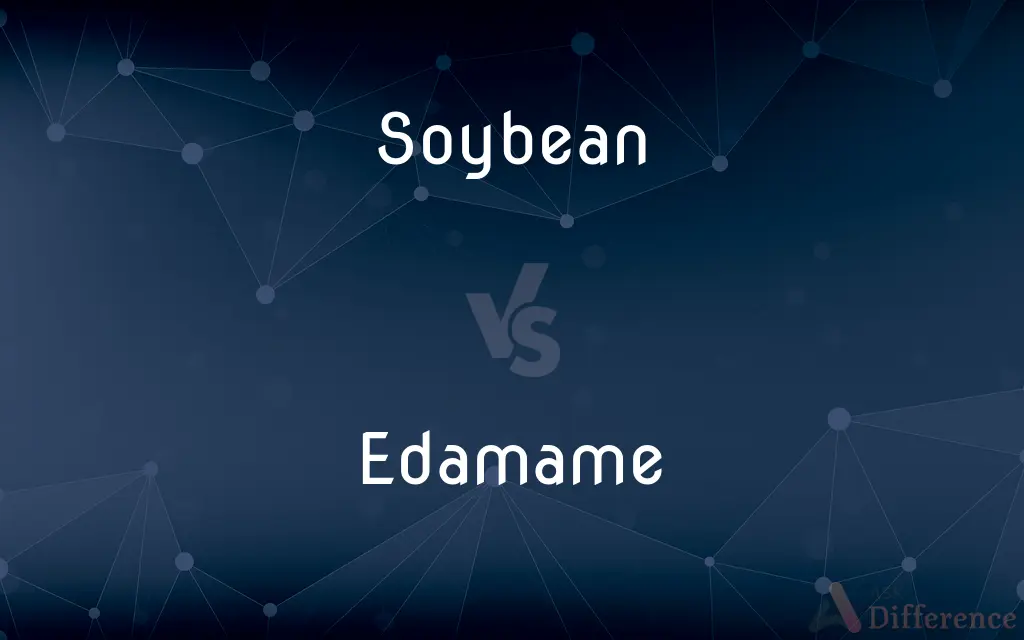Soybean vs. Edamame — What's the Difference?
By Tayyaba Rehman & Fiza Rafique — Updated on March 25, 2024
Soybean is a versatile legume used in various products, while edamame are young, green soybeans, often eaten steamed or boiled.

Difference Between Soybean and Edamame
Table of Contents
ADVERTISEMENT
Key Differences
Soybeans are a type of legume native to East Asia, widely grown for their edible beans which are used in a plethora of products like tofu, soy milk, and soy sauce. These beans can be of various colors, including yellow, black, and green, and are harvested when fully matured. On the other hand, edamame refers specifically to young, green soybeans that are harvested before they have ripened or hardened. Typically served steamed or boiled and often seasoned with salt, edamame is popular as a snack or appetizer, especially in Japanese cuisine.
While soybeans, in their mature form, are used in a wide range of culinary applications and industrial products, edamame is primarily consumed as a whole bean, including the soft, edible pods in some preparations. This difference highlights the versatility of soybeans beyond just their use as a snack and points to their broader application in food products and even non-food items, such as biodiesel and animal feed.
Nutritionally, both soybeans and edamame are rich in protein, fiber, and vitamins, but edamame, being harvested earlier, tends to be softer and is perceived as sweeter and more palatable when eaten directly. This makes edamame a popular choice for direct consumption, whereas mature soybeans often require processing to be edible or palatable.
The cultivation practices for soybeans destined for processing into foods or industrial products might differ from those grown specifically for harvest as edamame. This distinction is due to the different maturity stages at which the beans are harvested, which can affect the beans' flavor, texture, and nutritional content.
Both soybeans and edamame share the benefits of being plant-based sources of protein, making them important components of vegetarian and vegan diets. However, their use and preparation methods set them apart, with edamame serving as a straightforward, nutritious snack and soybeans being a versatile ingredient that's integral to various dietary staples and industrial products.
ADVERTISEMENT
Comparison Chart
Definition
Mature beans used in a wide range of food and industrial products.
Young, green soybeans eaten steamed or boiled.
Harvest Time
Matured
Before ripening
Color
Various colors, including yellow, black, and green.
Green
Primary Use
Culinary applications, industrial products, animal feed.
Snack or appetizer, mainly in East Asian cuisine.
Texture & Taste
Requires processing to be edible; varies based on product.
Softer, sweeter, and generally eaten whole.
Compare with Definitions
Soybean
Beans vary in color and are harvested when mature.
Yellow soybeans are commonly processed into animal feed.
Edamame
Harvested before the beans have ripened.
The edamame crop is picked while the pods are still green and tender.
Soybean
Integral to many diets and industries.
Soybeans serve as a crucial protein source in vegetarian diets.
Edamame
Young soybeans, green in color, served steamed or boiled.
Edamame was served as an appetizer with sea salt.
Soybean
Cultivated for its protein-rich beans.
The farm dedicated several acres to soybean cultivation.
Edamame
Popular in East Asian cuisine.
Edamame is a common side dish in Japanese restaurants.
Soybean
A legume used globally in various forms including tofu, soy milk, and soy sauce.
Soybeans are essential for producing tofu.
Edamame
Known for its sweet taste and soft texture.
The freshness of edamame adds a sweet, crunchy texture to salads.
Soybean
Used in industrial products like biodiesel.
Soybean oil is a key ingredient in biodiesel production.
Edamame
Eaten directly, sometimes with the pod.
She enjoyed her edamame sprinkled with chili powder.
Soybean
The soybean, soy bean, or soya bean (Glycine max) is a species of legume native to East Asia, widely grown for its edible bean, which has numerous uses. Traditional unfermented food uses of soybeans include soy milk, from which tofu and tofu skin are made.
Edamame
Edamame is a preparation of immature soybeans in the pod, found in cuisines with origins in East Asia. The pods are boiled or steamed and may be served with salt or other condiments.
Soybean
An annual leguminous plant (Glycine max) native to East Asia, widely cultivated for its seeds, which are used for food, as a source of oil, and as animal feed.
Edamame
Fresh green soybeans boiled as a vegetable.
Soybean
A seed of this plant.
Soybean
A legume plant (Glycine max), commonly cultivated for human and animal consumption and as a nitrogen-fixing ground cover.
Soybean
The edible seed of this plant.
Soybean
An Asiatic leguminous herb (Glycine max, formerly Glycine Soja) the seeds of which (also called soy beans) are used in preparing the sauce called soy. Called also soya bean and soya.
Soybean
The seeds of the Glycine max, which produce soybean oil; - called also soya bean.
Soybean
A source of oil; used for forage and soil improvement and as food
Soybean
Erect bushy hairy annual herb having trifoliate leaves and purple to pink flowers; extensively cultivated for food and forage and soil improvement but especially for its nutritious oil-rich seeds; native to Asia
Soybean
Most highly proteinaceous vegetable crop known
Common Curiosities
Why are soybeans important in agriculture?
Soybeans are a crucial crop for their protein content, versatility in food and industrial products, and as a component in animal feed.
What is the main difference between soybean and edamame?
Soybeans are harvested when fully matured and used in various products, while edamame is the term for young, green soybeans eaten while still soft.
Can edamame be used in cooking like mature soybeans?
While edamame can be added to dishes for its texture and flavor, its use is different from the more versatile mature soybeans, which are processed into various food products.
Can you eat soybeans raw like edamame?
Mature soybeans are not typically eaten raw due to their hard texture and potential antinutritional factors; they require processing, unlike edamame, which can be eaten boiled or steamed.
Are there any health benefits associated with eating edamame?
Yes, edamame is high in protein, vitamins, and fiber, making it a healthy snack option.
Is edamame as nutritious as mature soybeans?
Edamame is nutritious, rich in protein, fiber, and vitamins, and considered slightly sweeter and more palatable, though both forms are nutritionally valuable.
How do you prepare edamame for eating?
Edamame is typically prepared by boiling or steaming the pods and then serving them with salt or other seasonings.
Is edamame only popular in East Asian cuisine?
While it originated in East Asia, edamame has gained popularity worldwide as a healthy snack.
Are all soybeans edible in the form of edamame?
Only the young, green soybeans are eaten as edamame; mature soybeans are too hard and require processing.
What products are made from soybeans?
Products include tofu, soy milk, soy sauce, and biodiesel, among others.
How has the popularity of edamame affected soybean cultivation?
The growing demand for edamame outside of East Asia has led to increased cultivation in areas not traditionally known for soybean production.
How does the cultivation of soybeans for edamame differ from that for other uses?
Soybeans for edamame are harvested earlier when the beans are still green and tender, unlike those grown for processing or industrial use.
Why might someone choose edamame over other snacks?
For its nutritional benefits, including high protein and fiber content, as well as its pleasing taste and texture.
Can eating soybeans or edamame have any negative health effects?
In moderation, both are healthy. However, individuals with soy allergies should avoid them, and excessive consumption could lead to health issues due to phytoestrogens.
Share Your Discovery

Previous Comparison
Obvious vs. Clear
Next Comparison
Acetone vs. AcetateAuthor Spotlight
Written by
Tayyaba RehmanTayyaba Rehman is a distinguished writer, currently serving as a primary contributor to askdifference.com. As a researcher in semantics and etymology, Tayyaba's passion for the complexity of languages and their distinctions has found a perfect home on the platform. Tayyaba delves into the intricacies of language, distinguishing between commonly confused words and phrases, thereby providing clarity for readers worldwide.
Co-written by
Fiza RafiqueFiza Rafique is a skilled content writer at AskDifference.com, where she meticulously refines and enhances written pieces. Drawing from her vast editorial expertise, Fiza ensures clarity, accuracy, and precision in every article. Passionate about language, she continually seeks to elevate the quality of content for readers worldwide.















































